Note: Before repairing, you need to make sure that you can purchase spare parts (see par. 1 of this chapter). If you don't have any of the spare parts, contact your dealers or engine rebuilders.
Note: This procedure can be performed without removing the engine from the vehicle. But this is difficult due to limited access, and it also requires you to first remove various components. Therefore, we recommend that you perform this work after removing the engine. You will need new gaskets and other spare parts, as well as a lifting mechanism. You can also use the following tool to lift the power unit. It contains an adjustable support rod to be inserted into the drain holes on both sides of the engine compartment and a height adjustable hook to be hooked onto the lugs. The carrying capacity of this device (sold in auto stores) must exceed the weight of the engine together with the transmission.
1. Remove the head (-And) cylinder block (chapter 2A or 2B).
2. Remove the pallet (chapter 2A or 2B).
3. Remove the screws securing the oil pump intake pipe/strainer to the pump and remove the O-ring. On models with a V-shaped 6-cylinder engine, unscrew the nuts and remove the oil slinger from the crankcase (see Fig. 10.3, a-d). On models with a 4-cylinder engine from 05.1998, screw in the bolts and remove the lower crankcase frame.
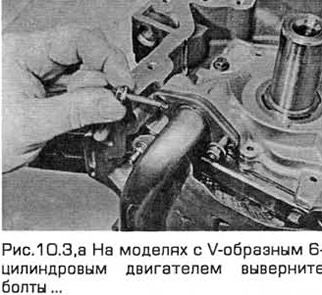
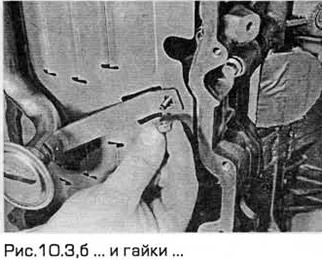
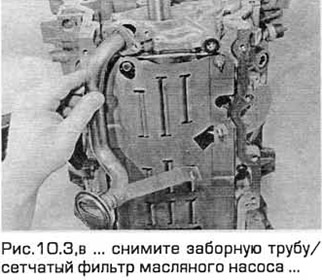
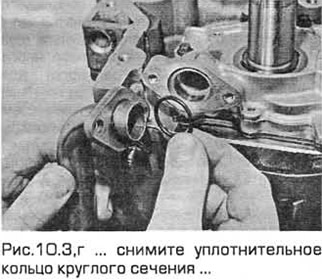
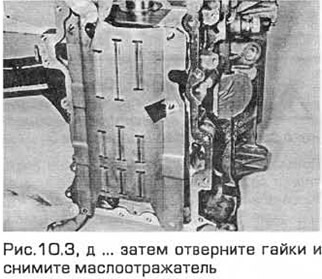
4. On models with a 4-cylinder engine manufactured from 05.1998, the design of the connecting rods and their covers does not provide for their disassembly. The covers are separated from the connecting rods due to breakage in a special way. Therefore, the mating surfaces for each connecting rod and its cap are unique and therefore these components cannot be mixed up (combine) with others.
5. Temporarily install the crankshaft pulley so that the crankshaft can be rotated. Please note that the connecting rod and piston groups are marked according to the cylinder numbers. The marking is etched on the machined plane of the connecting rod and its cover. These numbers are visible from the front of the engine (release side). In addition, an arrow is stamped on the bottom of each piston pointing towards the timing belt/chains of the engine. If the marks are not visible, then apply them before removing the components so that during installation, insert each connecting rod and piston group with the corresponding side into the corresponding cylinder and fix its cover with the corresponding side (see fig. 10.5, a, b).
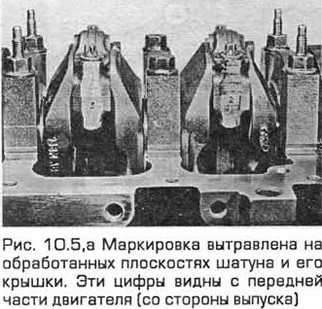
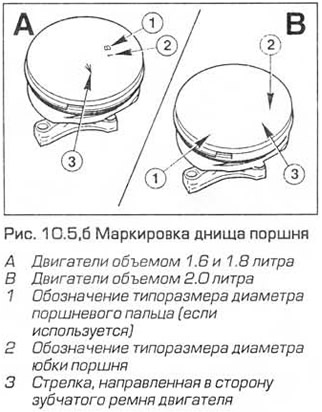
6. Run your fingernail along the top of the cylinder mirror to feel the step from the piston ring mirror (it is located approximately at a distance of 0.5 cm from the end of the cylinder). If ridges have formed in the cylinder due to soot or wear, then they must be removed with a special tool (see fig. 10.6). Follow the manufacturer's instructions for this tool.

Warning: If these ridges are not removed, the piston rings may be damaged when the pistons are removed.
7. On models with a 4-cylinder engine manufactured from 05.1998, remove the bolts securing the lower crankcase to the cylinder block. Loosen the bolts gradually and evenly. Then separate the lower crankcase from the cylinder block.
8. Loosen the connecting rod bearing cap bolts (half a turn at a time) So. so that they can be turned out by hand. Remove the cap and bearing from the connecting rod of the first cylinder. Make sure that the insert does not fall out of the cover.
9. Remove the upper bearing shell and push the connecting rod and piston group through the top of the cylinder with a wooden mallet, tapping the connecting rod shell cradle. If the knot is difficult to come out, then check again that all the combs have been removed from the cylinder.
10. Repeat this procedure on the remaining cylinders.
11. After removing the connecting rod and piston group, install the cover and liners, insert and tighten the bolts by hand. This is to protect against accidental damage to the bearing cradles. When installing, you need to use new inserts.
12. Don't try to separate the pistons from the connecting rods (see paragraph 12).
Visitor comments